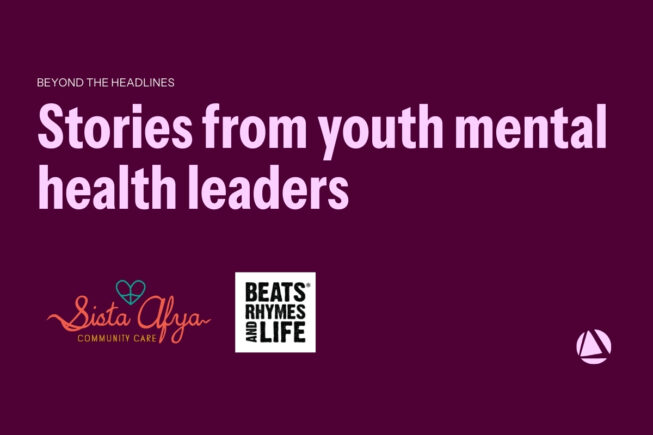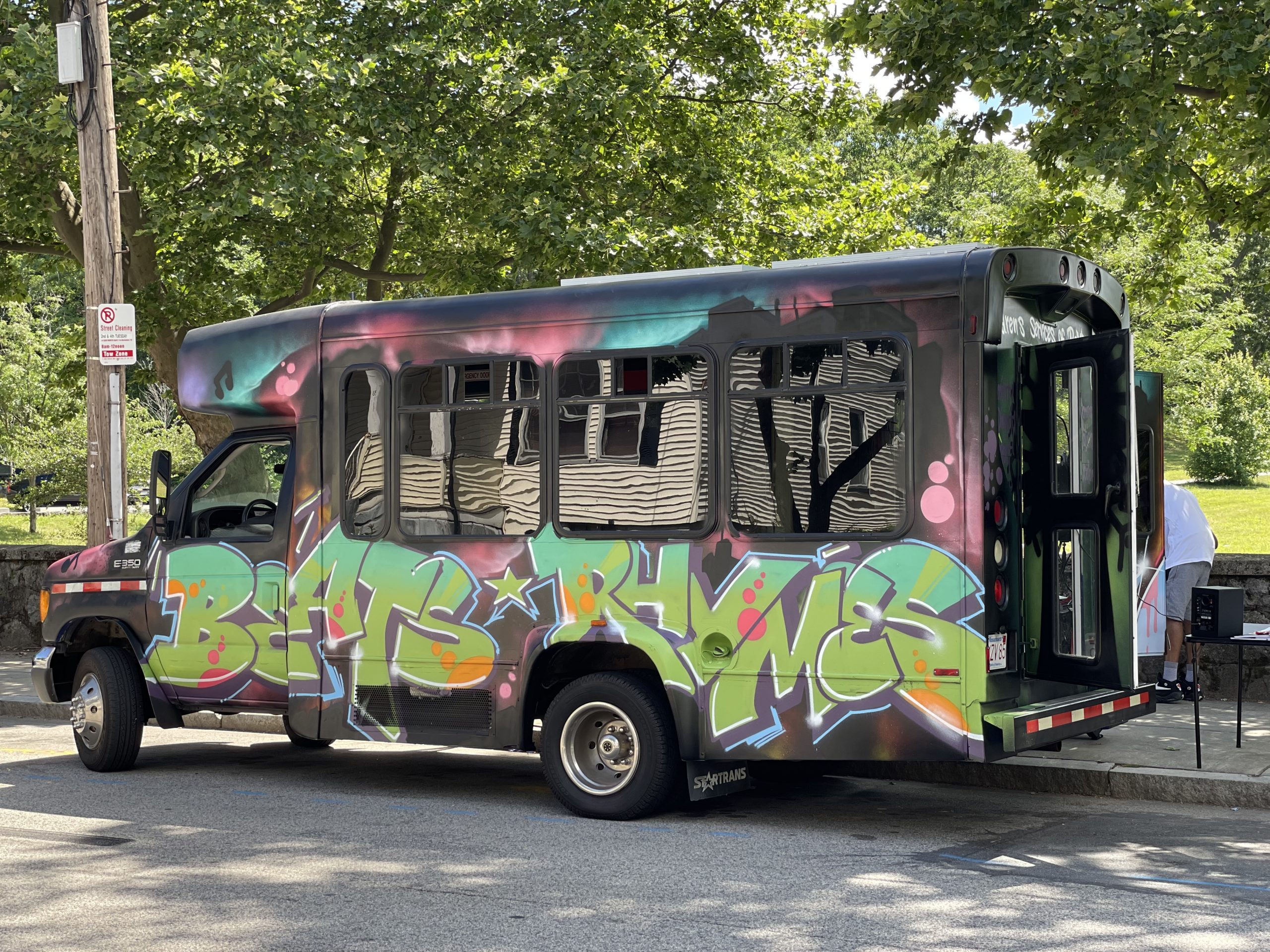Youth Mental Health: “It Doesn’t Have to Be Therapy to Be Therapeutic”

Missed part 1? Check it out here.
In May, we published “Beyond the Headlines: A Deep Dive into Trends and Opportunities in Youth Mental Health,” a landscape analysis in partnership with human-centered design firm, People Rocket. This report provides a clearer picture of where funding is flowing, where the most pressing gaps remain, and how philanthropy can drive meaningful change in access and opportunity.
One of the key themes from the landscape analysis? While it remains essential for some, traditional therapy isn’t always the first or most effective step for every young person.
Camesha Jones-Brandon, Executive Director of Sista Afya Community Care in Chicago, IL, and Rob Jackson, Chief Executive Officer / Founder of Beats Rhymes and Life in Oakland, CA—both alumni of New Profit’s 2023 Mental Health Equity Catalyze Cohort—help us understand how this insight shows up in practice:
- Start where youth are: physically, emotionally, and culturally. Mobile studios, group sessions, and community-rooted activities meet young people in their comfort zones.
- Bridge to care: These approaches don’t replace traditional therapy. Instead, they often serve as an entry point to deeper, more specialized support.
- Consider a broader investment: For funders, this serves as a reminder that investing in culturally grounded, community-based approaches is essential. These early, trust-building experiences often serve as the first step toward lasting mental wellness.
Meet Students Where They Are
A key finding from our landscape analysis was clear: healing doesn’t always begin with therapy. For many young people, especially those navigating complex social and systemic barriers, the first step toward wellness starts with trust, creativity, and culturally affirming environments.
That’s exactly what we heard from Rob and Camesha. Their approaches reflect a growing movement in youth mental health: one that sees value in meeting youth where they are, not waiting for them to show up in a clinic.
At Beats Rhymes and Life (BRL) in Oakland, Rob has been building healing spaces rooted in hip-hop culture for over two decades. For BRL, supporting youth mental health doesn’t always mean licensed therapy; it means showing up with consistency, creativity, and connection.
“We just had a talk at our staff meeting,” Rob shared. “What’s therapy vs. what’s therapeutic? There are programs we run that don’t involve clinicians…yet those programs still bring the same amount of healing and transformation.” Whether it’s a group session, a life skills workshop, or their mobile studio, BRL creates spaces that feel familiar, creative, and affirming. Their mobile music bus, launched during the pandemic, brings lyrical expression and connection directly into neighborhoods. As Rob put it, the goal isn’t to expect young people to come to them, but to meet them where healing can actually begin. It’s a model that shows up for youth both physically and emotionally, wherever they are.

Their work goes beyond access and is expanding how care is delivered and who gets to be part of it. Their Academy program supports young people in transitioning from receiving services to becoming peer specialists. Participants build facilitation skills, train in BRL’s model, and receive mental health support themselves. “In Alameda County, peer specialists are now recognized under Medi-Cal,” Rob noted. “That’s groundbreaking.” Medi-Cal, California’s Medicaid program, covers low-income residents, so this change means peer specialists can now be paid through public insurance.
Rob shared the story of Lemondre, who joined the program at Oakland High back in 2010. At first, he didn’t trust adults and didn’t want to be in school. Though bright, he struggled in the traditional K–12 school system. But Rob and the team built a relationship through steady check-ins, showing up when it mattered, even at court dates. Lemondre completed the Academy and today, 15 years later, is BRL’s Director of Artistry, supervising a staff of 10 and leading the organization’s community drives. Just last year, they gave out over 1,000 backpacks, 2,000 toys, and 300 food boxes. BRL’s work builds trust with young people, and in the process, helps shift how healing happens and who leads the way.
In Chicago, Camesha is taking an intentional, holistic approach shaped by the needs of young Black women in the community. At Sista Afya, mental wellness is nurtured through culturally grounded group sessions rooted in joy, vulnerability, and shared experience. Whether it’s healing circles, art therapy, or movement-based activities, the goal is to create spaces where girls feel seen, supported, and empowered to connect with others.
Over the last five years, Sista Afya has built a strong foundation working with Black women. About a year and a half ago, they expanded to serve teen girls, bringing the same community-based model into the youth mental health space. Group sessions, art-based workshops, and fitness programming have quickly become some of the most popular offerings. “Whenever we bring in art therapy, they love it, enjoy it, they’re all in”, Camesha said. There’s also been a growing interest in movement-based activities, especially girls’ sports. “Just movement in general has been really therapeutic,” she added, especially in group settings that center Black girls and build connection through community.
Sista Afya is also exploring emerging peer support models tailored for young people. One of them is the A.S.K. model (Acknowledge, Support, Keep in Touch), created by Active Minds and MTV, which emphasizes how peers, not just adults, can be a trusted source of care. “Your support system or circle of influence are the people closest to you”, Camesha explained. She’s now developing workshops based on the A.S.K. model to help young people care for each other in real and sustainable ways.
As a member of the Coalition on Urban Girls, Camesha also contributed to the white paper Are the Girls Well?, which explores how to adapt Maslow’s hierarchy of needs to support the safety and wellbeing of girls. This work reflects a broader effort to shift how mental health systems understand what girls truly need, not just through clinical care, but through a socioeconomic lens as well.
One young woman they worked with came to Sista Afya after experiencing severe bullying at school, so much so that her mother had to transfer her to a different school. She was withdrawn and isolated, even though she was attending weekly therapy. But something shifted when she participated in Sista Afya’s VIBE Day, a dedicated self-care event for Black girls. There, she made art, played games, created bath products, and bonded with other girls. “She lit up the room,” Camesha said. “She went from being closed off to being the life of the party.” It is a powerful example of how combining traditional individual therapy with social connection in a culturally grounded group setting can help a young person thrive. Even though she’s finished therapy, she continues to stay engaged with Sista Afya and now dreams of becoming a therapist or nurse.
Sista Afya’s approach shows how group work, peer connection, and culturally responsive care can complement traditional therapy and often reach young people in ways the medical model isn’t designed for. By creating spaces where girls feel safe and connected, they’re supporting both healing and shaping what care looks like in the future.
Both Rob and Camesha share the same belief: for many young people in their communities, traditional therapy can feel out of reach, or simply not the right fit at first. That’s why their organizations act as bridges, creating spaces where participants can begin to peel back the layers and “take off the mask,” a phrase echoed by Ashanti Branch, another leader we spoke with in the first post of this series, and start to define what healing looks like on their terms.
Eventually, some youth may access more formal mental health care. But first, they have to feel seen. And that starts by meeting them through music, conversation, and community, exactly where they are. That’s why investing in these early, trust-building experiences is essential: they’re where healing begins.
Check out Part 3 of our series, where we explore how youth mental health organizations are teaming up across sectors to build coordinated systems of support that truly center young people.